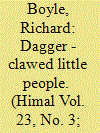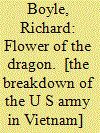|
|
|
Sort Order |
|
|
|
Items / Page
|
|
|
|
|
|
|
| Srl | Item |
| 1 |
ID:
095785


|
|
|
| 2 |
ID:
027482


|
|
|
|
|
| Publication |
San Francisco, Ramparts press, 1972.
|
| Description |
282p.
|
| Standard Number |
0878670203
|
|
|
|
|
|
|
|
|
|
|
|
Copies: C:1/I:0,R:0,Q:0
Circulation
| Accession# | Call# | Current Location | Status | Policy | Location |
| 013427 | 355.0218095997/BOY 013427 | Main | On Shelf | General | |
|
|
|
|
| 3 |
ID:
088321


|
|
|
|
|
| Publication |
2009.
|
| Summary/Abstract |
Sri Lanka is home to an array of ethnic groups, the smaller of which live partly outside the mainstream of society. Undoubtedly, the best known of these are the Veddah, who conform to the aboriginal, hunter-gatherer archetype. A lesser-known community, the only 'untouchable' group until the 1950s, is the Rodi. Indeed, the Rodi's intriguing myth of origin, their tragic history and the much-renowned beauty of their women, have combined to distinguish them. Not only has the tribe transformed into an oppressed caste in the mists of history, but the Rodi women have suffered disproportionately due to the burden of myths about their sexuality. While their beauty has been romanticised, the mystique of their sexual prowess has inspired both desire and fear in men of higher castes.
Although their beginnings are far from certain, it is possible that the Rodi were originally a hunting tribe from the Subcontinental mainland. Their current numbers are unknown, as Sri Lanka ceased to include caste in the population census almost a hundred years ago. Anthropologist Nireka Weeratunge's research in 1988 (the most recent to date) found one of the villages studied to have a larger population than the figure that had previously been used for the Rodi population for the Northwestern Province as a whole. While definite numbers thus cannot be cited, the Rodi population is today estimated to be around 25,000.
|
|
|
|
|
|
|
|
|
|
|
|
|
|
|
|
| 4 |
ID:
102047


|
|
|
| 5 |
ID:
088336


|
|
|
|
|
| Publication |
2009.
|
| Summary/Abstract |
In 1870, at the zenith of the British Empire, Queen Victoria was revered by subjugated peoples worldwide, including the Ceylonese. This was a time when loyalty to the throne and subservience to British rule was considered advantageous - most notably by the servile bourgeoisie who benefited both economically and socially from imperialism. So when it was announced that Queen Victoria's second son, Prince Alfred, the Duke of Edinburgh, was to be the first British royal to visit Ceylon, the mood was one of glorious expectation. One of the most important aspects of royal visits was the official record, used to communicate to Britain's population the loyal sentiments of the far-flung peoples of the colonies. In an age before electronic media, and when photography was still in its infancy, the reliance was instead on written accounts, supported by sketches and paintings, which were published in newspapers and periodicals.For Prince Alfred's visit, an illustrated book was commissioned to document the five-week stay. The individual chosen to write it was an Englishman resident in Ceylon, John Capper, the respected editor of the Times of Ceylon and a published author in his own right. Capper's documentation of the trip, entitled The Duke of Edinburgh in Ceylon: A book of elephant and elk sport, was published in London in 1871, containing 39 brief chapters and eight lithographic illustrations (see images). The volume begins by describing the local population's enthusiastic reaction to the impending visit. "That the children of the soil, the half-clad cultivators, the small traders, the untutored villagers, should have formed a willing army of workers was indeed something of which none had dreamed," Capper wrote. The reference here is to the labour force needed to construct the massive kraals (enclosures for captured elephants), fell large tracts of jungle, build roads and generally to erect a complete town for the prince, his entourage and other assorted visitors. It had taken thousands of workers three months to complete these monumental tasks.
|
|
|
|
|
|
|
|
|
|
|
|
|
|
|
|
|
|
|
|
|